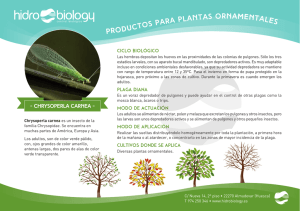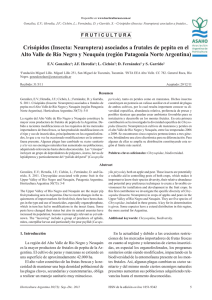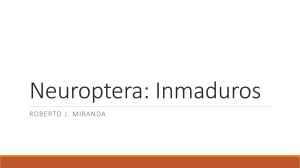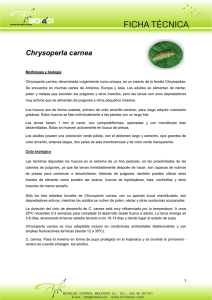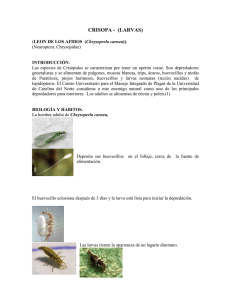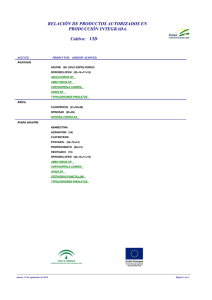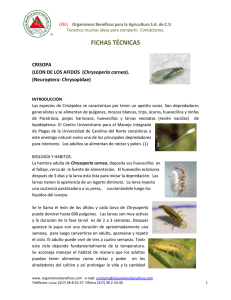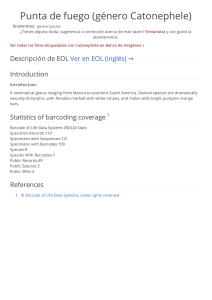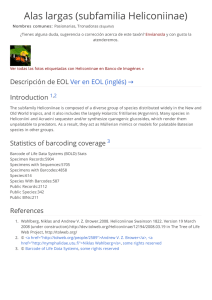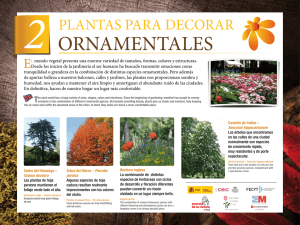First record of Chrysoperla asoralis and C. argentina (Neuroptera
Anuncio
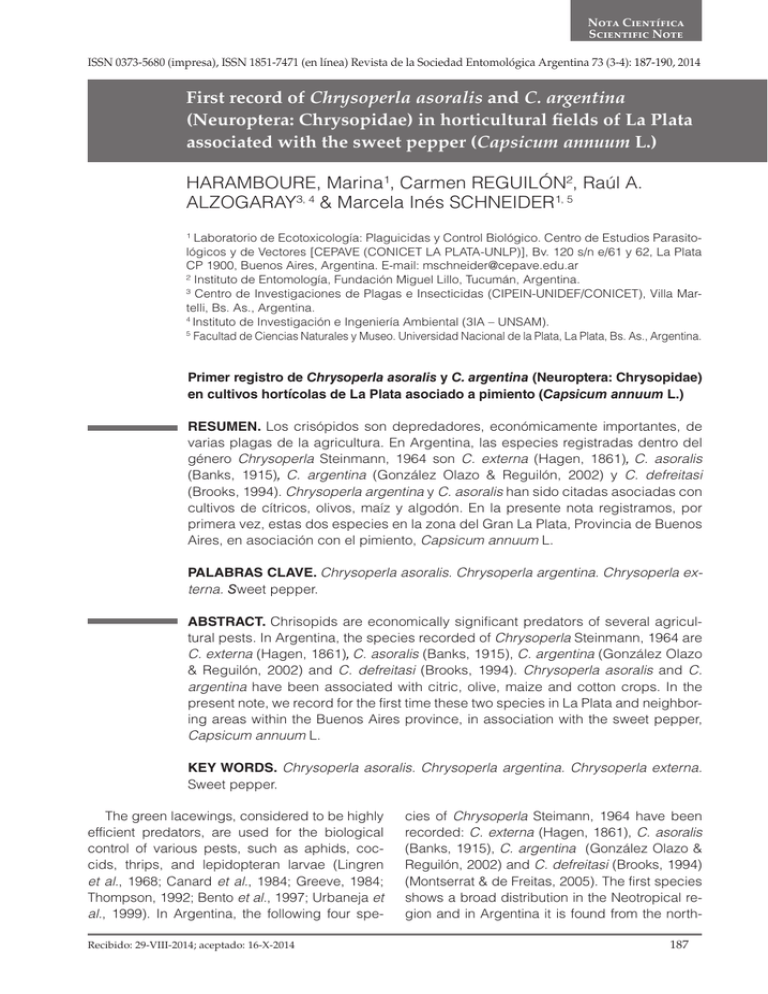
Nota Científica Scientific Note ISSN 0373-5680 (impresa), ISSN 1851-7471 (en línea) Revista de la Sociedad Entomológica Argentina 73 (3-4): 187-190, 2014 First record of Chrysoperla asoralis and C. argentina (Neuroptera: Chrysopidae) in horticultural fields of La Plata associated with the sweet pepper (Capsicum annuum L.) Haramboure, Marina¹, Carmen Reguilón², Raúl A. Alzogaray³, 4 & Marcela Inés Schneider¹, 5 ¹ Laboratorio de Ecotoxicología: Plaguicidas y Control Biológico. Centro de Estudios Parasitológicos y de Vectores [CEPAVE (CONICET LA PLATA-UNLP)], Bv. 120 s/n e/61 y 62, La Plata CP 1900, Buenos Aires, Argentina. E-mail: [email protected] ² Instituto de Entomología, Fundación Miguel Lillo, Tucumán, Argentina. ³ Centro de Investigaciones de Plagas e Insecticidas (CIPEIN-UNIDEF/CONICET), Villa Martelli, Bs. As., Argentina. 4 Instituto de Investigación e Ingeniería Ambiental (3IA – UNSAM). 5 Facultad de Ciencias Naturales y Museo. Universidad Nacional de la Plata, La Plata, Bs. As., Argentina. Primer registro de Chrysoperla asoralis y C. argentina (Neuroptera: Chrysopidae) en cultivos hortícolas de La Plata asociado a pimiento (Capsicum annuum L.) RESUMEN. Los crisópidos son depredadores, económicamente importantes, de varias plagas de la agricultura. En Argentina, las especies registradas dentro del género Chrysoperla Steinmann, 1964 son C. externa (Hagen, 1861), C. asoralis (Banks, 1915), C. argentina (González Olazo & Reguilón, 2002) y C. defreitasi (Brooks, 1994). Chrysoperla argentina y C. asoralis han sido citadas asociadas con cultivos de cítricos, olivos, maíz y algodón. En la presente nota registramos, por primera vez, estas dos especies en la zona del Gran La Plata, Provincia de Buenos Aires, en asociación con el pimiento, Capsicum annuum L. PALABRAS CLAVE. Chrysoperla asoralis. Chrysoperla argentina. Chrysoperla externa. Sweet pepper. ABSTRACT. Chrisopids are economically significant predators of several agricultural pests. In Argentina, the species recorded of Chrysoperla Steinmann, 1964 are C. externa (Hagen, 1861), C. asoralis (Banks, 1915), C. argentina (González Olazo & Reguilón, 2002) and C. defreitasi (Brooks, 1994). Chrysoperla asoralis and C. argentina have been associated with citric, olive, maize and cotton crops. In the present note, we record for the first time these two species in La Plata and neighboring areas within the Buenos Aires province, in association with the sweet pepper, Capsicum annuum L. KEY WORDS. Chrysoperla asoralis. Chrysoperla argentina. Chrysoperla externa. Sweet pepper. The green lacewings, considered to be highly efficient predators, are used for the biological control of various pests, such as aphids, coccids, thrips, and lepidopteran larvae (Lingren et al., 1968; Canard et al., 1984; Greeve, 1984; Thompson, 1992; Bento et al., 1997; Urbaneja et al., 1999). In Argentina, the following four speRecibido: 29-VIII-2014; aceptado: 16-X-2014 cies of Chrysoperla Steimann, 1964 have been recorded: C. externa (Hagen, 1861), C. asoralis (Banks, 1915), C. argentina (González Olazo & Reguilón, 2002) and C. defreitasi (Brooks, 1994) (Montserrat & de Freitas, 2005). The first species shows a broad distribution in the Neotropical region and in Argentina it is found from the north187 Revista de la Sociedad Entomológica Argentina 73 (3-4): 187-190, 2014 ernmost provinces down to the north of Patagonia (Adams & Penny, 1987); the second is likewise present from northern Argentina, to northern Patagonia (González Olazo & Heredia, 2007; González et al., 2011); C. argentina, however, has thus far been found only in the provinces of Salta, Chaco, La Rioja and Tucumán (González Olazo & Reguilón, 2002; Reguilón et al., 2006); while C. defreitasi has been recorded exclusively in the forests of the Yungas ecologic region in eastern Argentina (González et al., 2011) and in northern Patagonia (Montserrat & de Freitas, 2005). The species most thoroughly investigated is C. externa, with ecotoxicological studies recently having been reported (Iannacone & Lamas, 2002; Silva et al., 2006; Rimoldi et al., 2008, 2012; Schneider et al., 2009; Moura et al., 2012; Haramboure et al., 2013). The massive rearing and subsequent release in the field of that species has been promoted in several countries during recent years (Vargas, 1988; Daane & Yokota, 1997; Carvalho et al., 2002; Pappas et al., 2011). The horticultural zone of La Plata is one of the most extensive in the Buenos Aires province, occupying 65% of the greenhouse-cultivated area of the province (Censo Hortiflorícola, 2005). The sweet pepper (Capsicum annuum L.) is one of the main crops in this region, but is attacked in both the fruit and the plant proper by several pests, such as the green peach aphid Myzus persicae (Sulzer) (Barbosa et al., 2008) and the whitefly Bemisia tabaci (Genadius). Both these pests are of economic significance because of their direct effect on the plant itself through the sucking of the phloem and their secondary role as vectors of viral phytopathogens. In the horticultural agroecosystems of La Plata, the presence of C. externa has been detected in both organic and conventional fields, and in association with these two pests (Schneider, unpublished data). Samplings made in sweet pepper greenhous- Fig. 1. Distribution map of Chrysoperla asoralis (gray) and C. argentina (light blue) in Argentina. Figs. 2-4. Third instar larvae of 2) Chrysoperla asoralis with large rounded cephalic dorsolateral marks connected with the medium mark; 3) C. argentina with two narrow cephalic dorsolateral marks; 4) C. externa with a bifurcated anterodorsal medium mark and irregular dorsolateral marks. * Cardinal points were found in: http://sp.depositphotos.com/1075605/ stock-illustration-compass-rose.html. 188 HARAMBOURE, M. et al. First record of two Chrysoperla species in La Plata es in the area of La Plata, Buenos Aires province (34° 90’ 65.67” S, 58° 14’ 25.71” W) resulted in the capture of numerous specimens of the genus Chrysoperla. The species determination was done in the Miguel Lillo Foundation through the use of taxonomic keys. The material analyzed corresponded to C. asoralis and C. argentina, thus representing the first record for both species in the Buenos Aires province (Fig. 1) in addition to the association of those species with sweet pepper. The aim of this report is to provide a formal record of the presence of these two species in that region, gather information on their distribution, and report a new association with the sweet pepper per se. Furthermore, we have also included here the most relevant taxonomic characters of the larvae and adults of these species (Figs. 2-4 and 5-7). According to González Olazo et al. (2011), C. asoralis could be displacing C. externa on the basis of the high number of individuals found in several locations. Although more studies in the field have to be carried out in order to corroborate the hypothesis, an initial sampling done during a two-year period indicated that C. asoralis was more abundant than C. externa. For this reason, ecotoxicological studies are presently being carried out with an emphasis on a comparison of the susceptibility to insecticides between C. externa and C. asoralis (Haramboure et al. unpublished data). The association of C. asoralis with sweet- Figs. 5-7. Adults with head detail of 5) Chrysoperla asoralis, red postocular spot, pronotum without lateral bands; 6) C. argentina, dark brown genae; 7) C. externa, pronotum with red lateral bands, red genae. 189 Revista de la Sociedad Entomológica Argentina 73 (3-4): 187-190, 2014 pepper pests would point to that species as being a potential biologic control agent, with the possibility of ultimately being able to include this species in integrated-pest-management programs. These studies could also be useful in acquiring more information on the taxonomy of the Chrysoperla species before their mass rearing for field releases. ACKNOWLEDGEMENTS R.A.A. and M.I.S. are members of the Carrera del Investigador Científico y Tecnológico of the Consejo Nacional de Investigaciones Científicas y Técnicas from Argentina (CONICET). M.H. is a fellowship holder of CONICET. The financial support for this research was provided by the National Agency of Promotion of Science and Technology (ANPCyT-FONCYT, PICT 2011-1752). C.R. thanks Entomology Institute of Miguel Lillo Foundation, Tucumán. We are grateful to Jorge Barneche for his assistance to improve the figures. Dr. Donald F. Haggerty, a retired career investigator and native English speaker, edited the final version of the manuscript. LITERATURE CITED ADAMS, P. & N. PENNY. 1987. Neuroptera of the Amazon Basin. Part I. Introduction and Chrysopini. Acta Amazonica 15: 413-479. BARBOSA, L. R., C. F. CARVALHO, B. SOUZA & A. M. AUAD. 2008. Efficiency of Chrysoperla externa (Hagen, 1861) (Neuroptera: Chrysopidae) in the Myzus persicae (Sulzer, 1776) (Hemiptera: Aphididae) population reduction in sweet pepper (Capsicum annum L.). Ciência e Agrotecnologia 32(4): 1113-1119. BENTO, A., J. LOPES, L. TORRES & P. PASSOS-CARVAHLO. 1997. Biological control of Prays oleae by chrysopids in Tras-os-Montes region (Northeastern Portugal). Acta Horticulturae 474: 535-539. CANARD, M.,Y. SÉMÉRIA & T. R. NEW (Eds). 1984. Biology of Chrysopidae. Junk Publishers, The Hague. CARVALHO, G. A., C. F. CARVALHO, B. SOUZA & J. L. R. ULHOA. 2002. Seletividade de inseticidas a Chrysoperla externa (Hagen) (Neuroptera: Chrysopidae). Neotropical Entomology 31: 615-621. CENSO HORTIFLORÍCOLA. 2005. Buenos Aires. Ministerio de Asuntos Agrarios, Secretaria de Agricultura y Ganadería. http://www.maa.gba.gov.ar/archivos/informe_censo_hf.pdf DAANE, K. M. & G. Y. YOKOTA. 1997. Release strategies affect survival and distribution of green lacewings (Neuroptera: Chrysopidae) in augmentation programs. Enviromental Entomology 26(2): 455-464. GONZÁLEZ, E. V., J. F. HEREDIA , L. CICHÓN, D. FERNÁNDEZ & S. GARRIDO. 2011. Crisópidos (Insecta: Neuroptera) asociados a frutales de pepita en el Alto Valle de Río Negro y Neuquén (región Patagonia Norte Argentina). Horticultura Argentina 30(73): 5-8. GONZÁLEZ OLAZO, E. V. & C. REGUILÓN. 2002. Una nueva especie de Chrysoperla (Neuroptera: Chrysopidae) para 190 la Argentina. Revista de la Sociedad Entomológica Argentina 61(1-2): 47-50. GONZÁLEZ OLAZO, E. & F. HEREDIA. 2007. Los Chrysopidae (Insecta: Neuroptera) de la ecorregión paranaense argentina. Fac. de Cienc. Naturales U.N.T, Serie Monográfica y Didáctica 46: 71. GREEVE, L. 1984. Chrysopid distribution in northern latitudes. In Canard, M., Y. Séméria & T. R. New (eds.), Biology of Chrysopidae, Junk Publishers, The Hague, The Netherlands, pp. 180-186. HARAMBOURE, M., N. FRANCESENA, G. R. REBOREDO, G. SMAGGHE, R. A. ALZOGARAY & M. I. SCHNEIDER. 2013. Toxicity of cypermethrin on the Neotropical lacewing Chrysoperla externa (Neuroptera: Chrysopidae). Communications in Applied Biological Sciences, 78(2): 339-344. IANNACONE, J. & G. LAMAS. 2002. Efecto de dos extractos botánicos y un insecticida convencional sobre el depredador Chrysoperla externa. Manejo Integrado de Plagas y Agroecología 65: 92-101. LINGREN, P. D., R. L. RIDGWAY & S. L. JONES. 1968. Consumption by several arthropod predators of eggs and larvae of two Heliothis species that attack cotton. Annals of Entomological Society of America 61: 613-618. MONSERRAT, D. J. & S. DE FREITAS. 2005. Contribución al conocimiento de los crisópidos de Coquimbo, Patagonia y Tierra del Fuego (Argentina, Chile) (Insecta, Neuroptera. Chrysopidae). Graellsia 61(2): 163-179. MOURA, A. P., G. A. CARVALHO & M. BOTTON. 2012. Residual effect of pesticides used in integrated apple production on Chrysoperla externa (Hagen) (Neuroptera: Chrysopidae) larvae. Chilean Journal of Agricultural Research 72(2): 217-223. PAPPAS, M. L., G. D. BROUFAS & D. S KOVEOS. 2011. Chrysopid Predator and their role in Biological Control. Journal of Entomology 8(3): 301-326. REGUILÓN, C., E. V. GONZÁLEZ OLAZO & S. R. NÚÑEZ CAMPERO. 2006. Morfología de los estados inmaduros de Chrysoperla argentina (Neuroptera: Chrysopidae). Acta Zoológica Lilloana 50(1–2): 31–39. RIMOLDI, F., M. I. SCHNEIDER & A. E. RONCO. 2008. Susceptibility of Chrysoperla externa Eggs (Neuroptera: Chrisopidae) to Conventional and Biorational Insecticides. Environmental Entomology 37(5): 1252-1257. RIMOLDI, F., M. I. SCHNEIDER & A. E. RONCO. 2012. Short and Long-Term Effects of Endosulfan, Cypermethrin, Spinosad, and Methoxyfenozide on Adults of Chrysoperla externa (Neuroptera: Chrysopidae). Journal of Economic Entomology 105(6): 1982-1987. SCHNEIDER, M. I., N. SANCHEZ, S. PINEDA, H. CHI & A. RONCO. 2009. Impact of glyphosate on the development, fertility and demography of Chrysoperla externa (Neuroptera: Chrysopidae): Ecological approach. Chemosphere 76: 1451–1455. SILVA, R. A., G. A. CARVALHO, C.F. CARVALHO, P. R. REIS, B. SOUZA, A. M. ANDRADE & R. PEREIRA. 2006. Action of pesticides used in coffee crops on the pupae and adults of Chrysoperla externa (Hagen, 1861) (Neuroptera: Chrysopidae). Ciência Rural, Santa Maria 36(1): 8-14. THOMPSON, W. T. 1992. A worldwide guide to beneficial animals used for pest control purposes. Thompson Publications, Fresno, CA. URBANEJA, A., E. LLÁCER, O. TOMÁS, A. GARRIDO & J. JACAS. 1999. Effect of temperature on development and survival of Cirruspilus sp. near lyncus (Hymenoptera: Eulophidae), parasitoid of Phyllocnistis citrella (Lepidoptera: Gracillaridae). Environmental Entomology 28: 339-344. VARGAS, S. C. 1988. Estudio sobre técnicas y equipos para la producción masiva del depredador Chrysoperla carnea (Stephens) (Neuroptera : Chrysopidae). Revista Palmas, Norteamérica. Disponible en: <http://publicaciones.fedepalma.org/index.php/palmas/article/view/192>.
